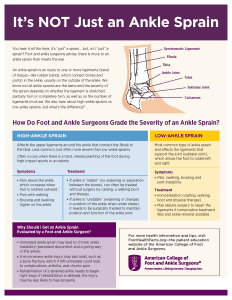You hear it all the time, it’s “just” a sprain… but, is it “just” a sprain? Foot and ankle surgeons advise, there is more to an ankle sprain than meets the eye. An ankle sprain is an injury to one or more ligaments (band of tissues—like rubber bands, which connect bones and joints) in the ankle, usually on the outside of the ankle. We know not all ankle sprains are the same and the severity of the sprain depends on whether the ligament is stretched, partially torn or completely torn, as well as on the number of ligaments involved. We also hear about high-ankle sprains vs. low-ankle sprains, but what’s the difference?
How Do Foot and Ankle Surgeons Grade the Severity of an Ankle Sprain?
For more health information and tips, visit FootHealthFacts.org—the patient education website of the American College of Foot and Ankle Surgeons.
LOW ANKLE SPRAIN
Most common type of ankle sprain and affects the ligaments that support the joint (subtalar joint),
which allows the foot to rotate left and right.
Symptoms
- Pain, swelling, bruising and joint instability
Treatment
- Immobilization (casting, walking boot and physical therapy)
- May require surgery to repair the ligaments if conservative treatment
fails and ankle remains unstable.
Why Should I Get an Ankle Sprain Evaluated by a Foot and Ankle Surgeon?
- Untreated ankle sprain may lead to chronic ankle instability (persistent discomfort and a giving way of the ankle).
- A more severe ankle injury may also exist, such as a bone fracture, which if left untreated could lead to complications, arthritis, and chronic pain.
- Rehabilitation of a sprained ankle needs to begin right away. If rehabilitation is delayed, the injury may be less likely to heal properly.
Contact Us at
302-674-9255 (WALK)


